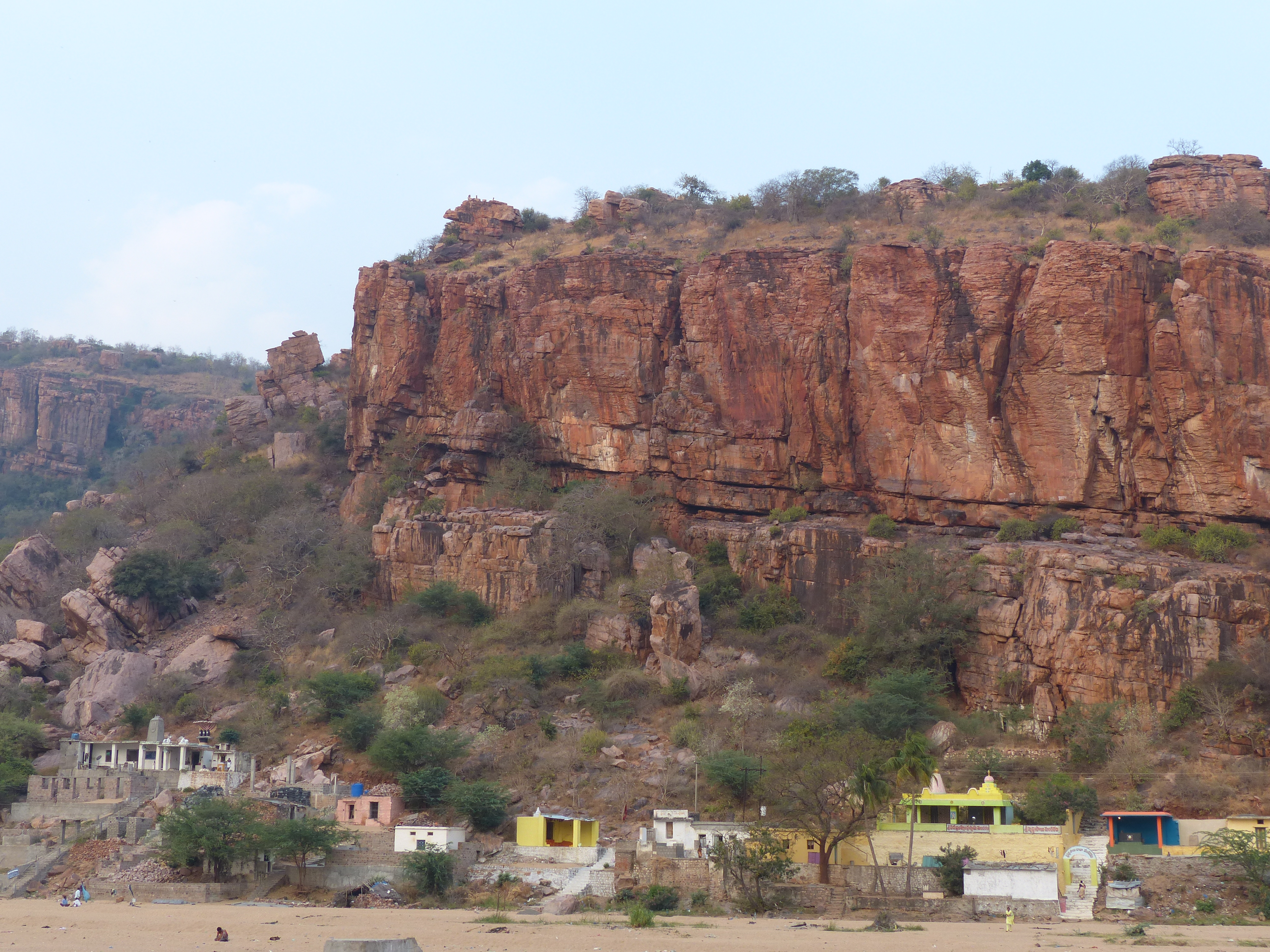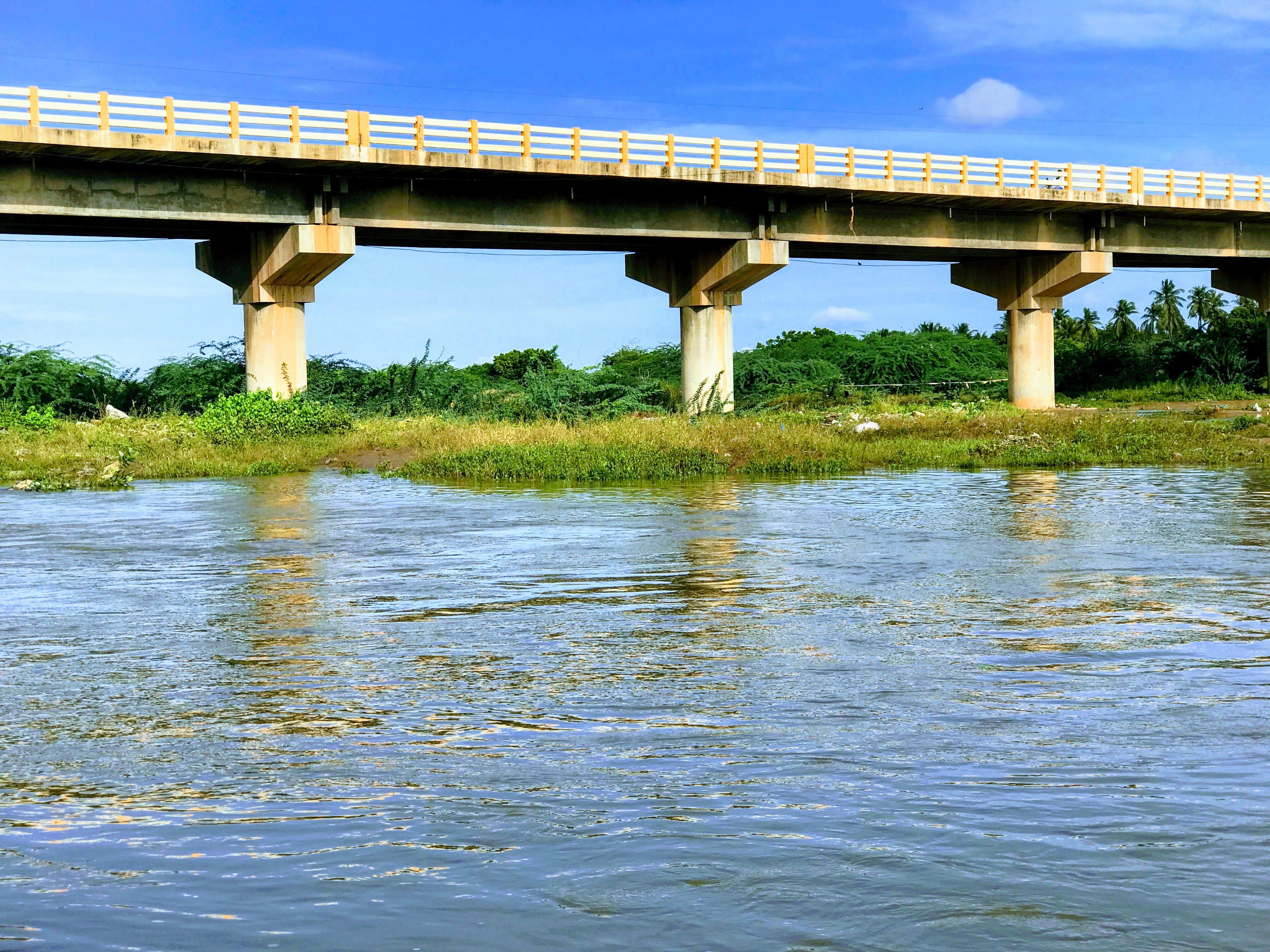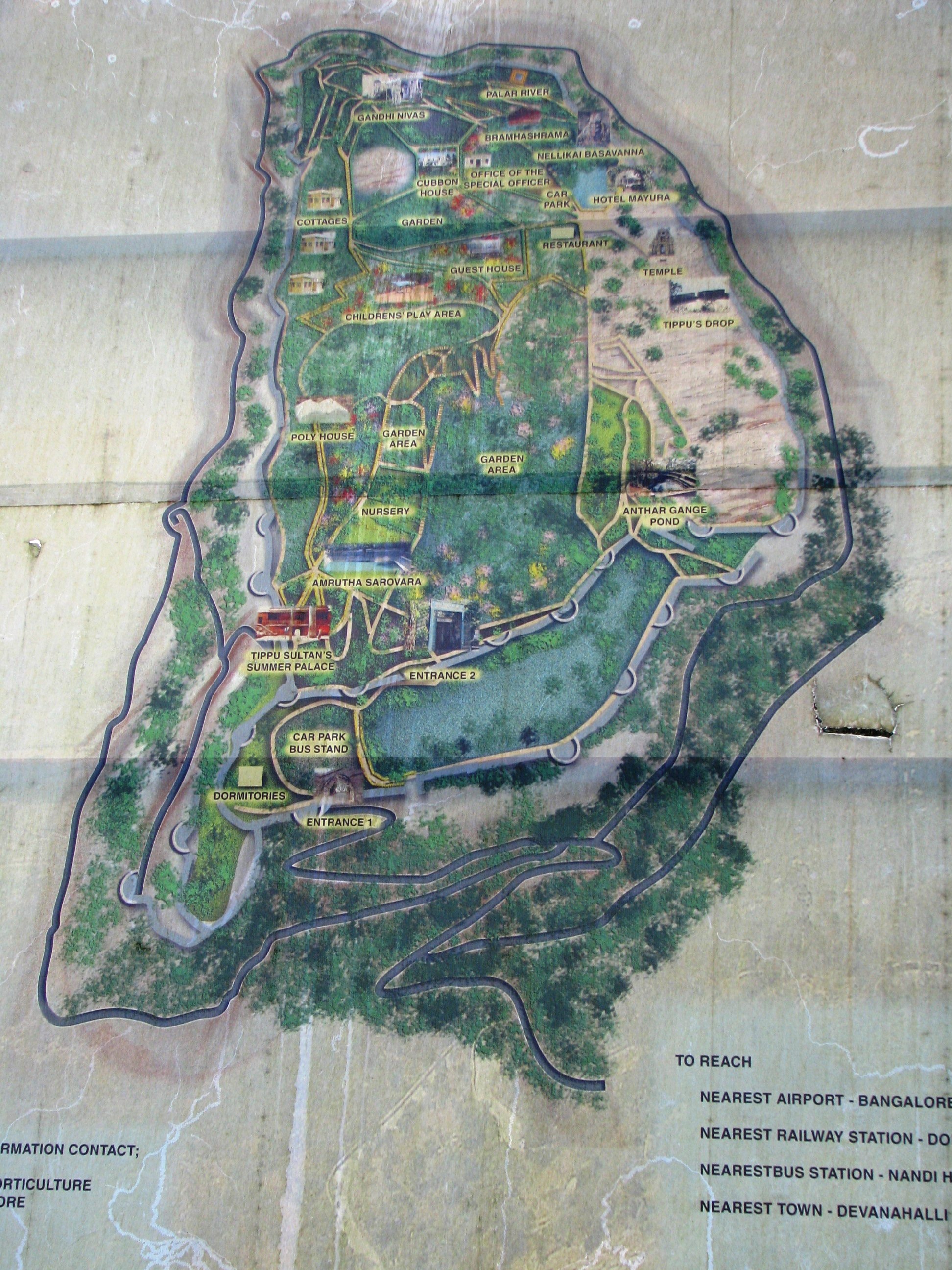|
Pennar
Penna (also known as Pinakini, Pennar, Penner, Penneru (Telugu), Pennai (Tamil)) is a river of southern India. This is a unique river in world where after originating from Nandi hills, it flows as two different streams, one in North and South directions. The Penna rises in the Nandi Hills in Chikkaballapur District of Karnataka state, and runs north and east through the states of Karnataka and Andhra Pradesh to empty into bay of bengal in Andhra Pradesh. It is long, with a drainage basin covering 55,213 km2: 6,937 km2 in Karnataka and 48,276 km2 in Andhra Pradesh. Along with this main stream there is another stream south towards Tamilnadu with the name Then Pennai or south Pennar which further moves towards the east to empty into the Bay of Bengal.The Penna river basin lies in the rain shadow region of Eastern Ghats and receives 500 mm average rainfall annually. Etymology Since the river flows in two streams, both North and South directions, it forms th ... [...More Info...] [...Related Items...] OR: [Wikipedia] [Google] [Baidu] |
Ponnaiyar River
The South Pennar River (also known as ''Dakshina Pinakini'' in Kannada and ''Thenpennai or Ponnaiyar'' or ''Pennaiyar'' in Tamil) is a river in India. Bangalore, Hosur, Tiruvannamalai, and Cuddalore are the important cities on the banks of South Pennar river. This is the second longest river in Tamil Nadu, with a length of 497km, after the Kaveri. Chandapura, Anekal, Hosur, Bagalur and Chengam are the major industrial settlements on its banks. The river is severely polluted by industrial waste as it flows through major industrial areas in the eastern suburbs of Bangalore, Industrial parks of Hosur and Chengam. The river originates in the Nandi Hills in the Chikkaballapura district of Karnataka and flows through Tamil Nadu before emptying into the Bay of Bengal. It has a catchment area of located in Karnataka and Tamil Nadu states. Small dams of Kelavarapalli and Krishnagiri Dams are built across this river near Hosur and Krishnagiri. The largest dam on this river, Sathanu ... [...More Info...] [...Related Items...] OR: [Wikipedia] [Google] [Baidu] |
Papagni River
Papagni River is a non-perennial, inter-state river in southern India that flows through the states of Karnataka and Andhra Pradesh. It is a right bank tributary of the Pennar river. Etymology ''Pāpāgni'' is a compound of the words ''pāpa'' (meaning sin) and ''agni'' (meaning fire). According to legend a king who once killed an innocent tribal chieftain of the Chenchus, who live in this region, was afflicted by leprosy as punishment for his sin. He was supposedly cured of the affliction only after he undertook penance in the Papagni valley and took a dip in the river upon which the river is said to have turned his sins to ashes thus acquiring for itself the name ''Pāpāgni''. Course The Papagni originates in the Nandi Hills of Chikkaballapur district in Karnataka. It is a non-perennial river that is rainfed with its basin receiving 60–80 cm of rainfall annually. It traverses through a region of granitic deposits and red soil that is frequently affected by soil ... [...More Info...] [...Related Items...] OR: [Wikipedia] [Google] [Baidu] |
Cheyyeru River
Cheyyeru river is a river in the southern Indian state of Andhra Pradesh that is a tributary of the Pennar river. Course The Cheyyeru is formed by the confluence of the rivers Bahuda and Puncha that originate in Andhra Pradesh. The two streams join at Rayavaram to form the Cheyyeru which then flows for 87 km before joining the Pennar as a right bank tributary at Gundlamada in the Sidhout taluk of Kadapa district, draining a total area of 7,325 km2. The Gunjana river is a tributary of the Cheyyeru and along the Gunjana valley several paleolithic settlements have been discovered. There are several gorges on the river including one after the confluence of its headstreams and the Balarajupalle gorge. The Cheyair series of rocks in the Cudappah rock system of the Eastern Ghats, consisting largely of shales, is named after the Cheyyeru river. Waterworks The Cheyyeru project comprising the 409 metre long Annamayya earthen dam that provides irrigation facilities ... [...More Info...] [...Related Items...] OR: [Wikipedia] [Google] [Baidu] |
Tadipatri
Tadipatri or Tadpatri is a city in Anantapur district of the States and territories of India, Indian state of Andhra Pradesh at the border of Kurnool district and Kadapa district. It is the mandal headquarters of Tadipatri mandal in Anantapur revenue division. The Chintala Venkataramana Temple is located on a five acre site in Tadipatri. The Bugga Ramalingeswara temple, Bugga Ramalingeswara Temple is located one kilometer from the town, overlooking the Penna River. Etymology Tadipatri was first a village called Tallapalle. It was developed into a town and renamed as Tadipatri by Pemmasani Ramalinga Nayudu I of the Pemmasani Nayaks, who made this town his seat of government and later developed as a major city in Anantapur district.: Geography Tadipatri is located at . Its average elevation is 223 metres or 731 feet. Tadipatri lies on the southern bank of Penner River, Pennar River. Due to MPR Dam, Mid Pennar Dam constructed upstream, the section of river in Tadipatri is usual ... [...More Info...] [...Related Items...] OR: [Wikipedia] [Google] [Baidu] |
Sagileru
Sagileru is a river in the southern Indian state of Andhra Pradesh that is a tributary of the Pennar. Sagileru basin The Sagileru river valley lies between the Velikonda and Nallamala hills and has a north-south orientation. The river basin contains red, black and loamy soils and both wet and dry irrigated crops are grown in this region with bajra, ragi, jowar, groundnuts and vegetables belonging to the latter category. Waterworks The Upper and Lower Sagileru projects are medium irrigation projects on the river and are located in the B.Kodur and Kalasapadu mandals of Kadapa district. Besides these there are several lift irrigation Periyar lift irrigation in Kadungallur, Kerala ">Kerala.html" ;"title="Kadungallur, Kerala">Kadungallur, Kerala Lift irrigation is a method of irrigation in which water is not transported by natural flow, (as in gravity-fed canal) but is lif ... and minor irrigation works on the river. The Telugu Ganga canal project aims to enhance the ... [...More Info...] [...Related Items...] OR: [Wikipedia] [Google] [Baidu] |
Bangalore
Bangalore (), officially Bengaluru (), is the capital and largest city of the Indian state of Karnataka. It has a population of more than and a metropolitan population of around , making it the third most populous city and fifth most populous urban agglomeration in India, as well as the largest city in South India, and the 27th largest city in the world. Located on the Deccan Plateau, at a height of over above sea level, Bangalore has a pleasant climate throughout the year, with its parks and green spaces earning it the reputation as the "Garden City" of India. Its elevation is the highest among the major cities of India. An aerospace, heavy engineering and electronics hub since the 1960s, Bangalore is widely regarded as the "Silicon Valley of India" because of its role as the nation's leading information technology (IT) exporter.——— In the Ease of Living Index 2020 (published by the Ministry of Housing and Urban Affairs), it was ranked the most livable Indian ... [...More Info...] [...Related Items...] OR: [Wikipedia] [Google] [Baidu] |
Chitravathi River
The Chitravathi is an inter-state river in southern India that is a tributary of the Penna River. Rising in Karnataka, it flows into Andhra Pradesh and its basin covers an area of over 5,900 km2. The pilgrim town of Puttaparthi is located on its banks. Course Chitravathi river originates at Chikkaballapur and flows through the Chikkaballapur district of Karnataka before entering Andhra Pradesh where it drains the districts of Anantapur and Cuddapah before joining the Penna. The Chitravathi river basin covers an area of 5,908 km2. The mandals that it drains in the two states are Bagepalli, Gorantla, Hindupur, Puttaparthi, Bukkapatnam, Dharmavaram, Tadipatri and Mudigubba. The river joins the Penna at Gandikota in Kadapa district where the Gandikota irrigation project is being undertaken by the Government of Andhra Pradesh as part of its Jalayagnam project. Chitravathi is a seasonal river that comes alive after the monsoons. Along with the Papagni, it forms a part ... [...More Info...] [...Related Items...] OR: [Wikipedia] [Google] [Baidu] |
South India
South India, also known as Dakshina Bharata or Peninsular India, consists of the peninsular southern part of India. It encompasses the Indian states of Andhra Pradesh, Karnataka, Kerala, Tamil Nadu, and Telangana, as well as the union territories of Lakshadweep and Puducherry, comprising 19.31% of India's area () and 20% of India's population. Covering the southern part of the peninsular Deccan Plateau, South India is bounded by the Bay of Bengal in the east, the Arabian Sea in the west and the Indian Ocean in the south. The geography of the region is diverse with two mountain ranges – the Western and Eastern Ghats – bordering the plateau heartland. The Godavari, Krishna, Kaveri, Tungabhadra, Periyar, Bharathappuzha, Pamba, Thamirabarani, Palar, and Vaigai rivers are important perennial rivers. The majority of the people in South India speak at least one of the four major Dravidian languages: Tamil, Telugu, Malayalam and Kannada (all 4 of which are among the 6 Classic ... [...More Info...] [...Related Items...] OR: [Wikipedia] [Google] [Baidu] |
Nandi Hills, India
Nandi Hills (Anglicised forms include ''Nandidurg'' and ''Nandydoorg'') is an ancient hill station built by Ganga Dynasty in the Chikkaballapur district of Karnataka state. It is 10 km from Chickballapur town and approximately 60 km from Bengaluru. The hills are near the town Nandi. In traditional belief, the hills are the origin of the Arkavathy river, Ponnaiyar River, Palar River, Papagni River and Penna River. Watching the sunrise at Nandi Hills is popular with tourists. The first ever SAARC summit hosted by India was held at Nandi Hills in 1986. Etymology There are many stories about the origin of the name Nandi Hills. During the Chola period, Nandi Hills was called Anandagiri meaning The Hill of Happiness. It is also perhaps called Nandi Hills because the hills resemble a sleeping bull. Another theory holds that the hill gets its name from an ancient, 1300-year-old, Dravidian-style temple, and for the Nandi (bull), statue situated on this hill. History Nandi Hi ... [...More Info...] [...Related Items...] OR: [Wikipedia] [Google] [Baidu] |
Chikballapur District
Chikkaballapura district is a district in the state of Karnataka, India. On 23 August 2007, it was carved out of the pre-existing Kolar district which was the fourth largest district (before bifurcation) of Karnataka by moving the talukas of Gauribidanur, Gudibanda, Bagepalli, Chikballapur, Manchenahalli, Sidlaghatta and Chintamani into the new district. Kannada is the official and most widely spoken language. The town of Chikballapur is the district headquarters and a key transport link in the North Bangalore area. The north-south six-lane National Highway 44 (NH-44) as well as the East-West Highway 69 go through the district. A rail line runs north from Bangalore to the town of Chikballapur, east past Doddaganjur to Srinivaspur and south to the town of Kolar. Bhoganandishwara Temple, Bhoga Nandeeshwara Temple (also spelt "Bhoga Nandishwara" or "Bhoga Nandishvara") is a Hindu temple located in Nandi village, at the base of Nandi Hills, Karnataka, Nandi Hills (or Nandidurga) i ... [...More Info...] [...Related Items...] OR: [Wikipedia] [Google] [Baidu] |
Kundu River
The Kundu River also known as ''Kunderu'', ''Kumudvathi'' is a tributary of the Penna River in the Rayalaseema region of Andhra Pradesh, India. Originating as a spring near the village of Uppalapadu in Orvakal Mandal of Kurnool District, it goes through many changes before merging with the Penna at kamalapuram of Kadapa District. It is known for frequent floods that bring heavy damage to the Nandyal and Koilkuntla areas, and hence it is popularly called the "Sorrow of Nandyal." But nowadays Nandyal town became a big town with huge population so that the drainage water is discharged to the Kundu river without prior treatment. Industrialists focused their vision at more and more profits and they polluted the river to the maximum extent. The villagers who are living at down flow of the river from Nandyala are suffering with different skin diseases. The pollution impacts even animals health too. In ancient times this river was known as the Kumudvathi. There is a saying in Rayalase ... [...More Info...] [...Related Items...] OR: [Wikipedia] [Google] [Baidu] |






